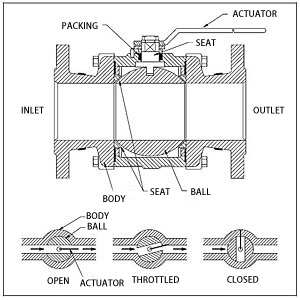You are here:Home » Knowledge Base » Details
Valves Components and Operating Principal
As a common piece for equipments in fluid processing facilities, sanitary valves are different in types, shapes and sizes. However, they all basically consist of some of the parts defined as follows:
- Body: the framework that holds everything together and serves as the pressure boundary.
- Bonnet: the cover on the valve body. During valve manufacturing, the internal parts are put into the body and then the bonnet is attached to hold everything together inside. Some types of valves (ball valve for example) don’t have this part.
- Handle and Actuator: the handle is mainly used to manually open or close the valve; the actuator, pneumatic or electric, is used to automatically or remotely control the valve. Some valves, check valves and relief valves for example, have neither handle nor actuator because they automatically control themselves from the inside.
- Disc/Ball: a movable obstruction inside the body that controls the flow through the valve.
- Stem: the part that transmits the motion of the handle/actuator to the disc/ball.
- Packing: the seal between the stem and the bonnet that prevents leakage.
- Seat: the seating surface for the disc/ball.
To describe the basic operating principle of valves, take the typical ball valve for example:
| The flow through the valve is mainly controlled by the handle and the ball, which has a cylindrical hole in the middle. By rotating the handle you can set the hole in line with the valve inlet and outlet to release the flow, or perpendicular to the flow pass to stop it. |  |
| The Typical Ball Valve |
Prev: Seat Leakage Classifications for Sanitary Valves Next: How to extend the life of valves and fittings?
